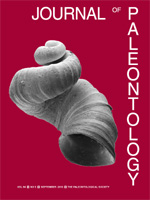The enigmatic fossil Moniopterus japonicus Hatai et al., 1974 from the early Middle Miocene Moniwa Formation of northern Japan has been described as the only known example of fossil sea-snake eggs and also as fossilized pupal chambers of a coleopteran insect. A reexamination of the holotype provides no evidence in support of these previous interpretations. Scanning electronic microscopy and computed tomography observations on the holotype reveal that the calcareous lining, previously interpreted as eggshell, is instead composed of irregular spherulitic prisms, thin in the middle and becoming thicker toward both ends. In addition to the elongate oval shape and the presence of an opening at the more pointed end, these observations strongly suggest that M. japonicus is a boring of the mytilid boring bivalve Lithophaga isolated from the host rock. This reinterpretation is further supported by the occurrence of similar isolated and in situ borings with Lithophaga shells within the type and a nearby locality. Regarding this fossil as an ichnofossil makes the generic name Moniopterus a junior synonym of Gastrochaenolites Leymerie, 1842 and the species name japonicus is a senior synonym of Gastrochaenolites torpedo Kelly and Bromley, 1984. G. torpedo should thus be replaced with Gastrochaenolites japonicus (Hatai et al., 1974).
How to translate text using browser tools
1 September 2010
Reinterpretation of the Miocene Sea-Snake Egg Moniopterus japonicus as a Boring of Rock-Boring Bivalve Lithophaga (Mytilidae: Mollusca)
Takuma Haga,
Yukito Kurihara,
Tomoki Kase
ACCESS THE FULL ARTICLE

Journal of Paleontology
Vol. 84 • No. 5
September 2010
Vol. 84 • No. 5
September 2010
boring bivalve
egg
Gastrochaenolites
microstructure
Moniwa Formation
Sea-snake




